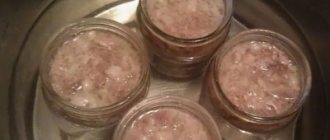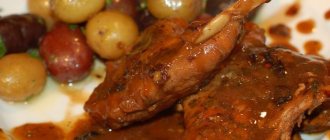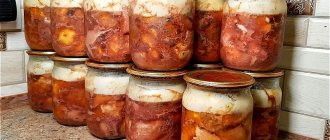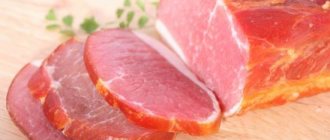Domestic rabbit meat is a tasty and healthy product with dietary and hypoallergenic properties. However, it is not always possible to purchase fresh and high-quality goods. A solution to this problem can be the preparation of meat for future use using the preservation method - rabbit stew, thanks to which its taste and aroma, as well as all useful microelements, are preserved.
Before you start preparing rabbit stew, you should familiarize yourself with some of the features of selecting and preparing raw materials for preservation:
- When purchasing a rabbit carcass at a butcher shop, you should pay attention to the possible presence of odor. If the meat thins out the light aroma of hay, then this means that the animal was old. It is not recommended to take such meat, as when cooked it turns out tough and dry. The meat of young animals should have virtually no odor.
- Before cooking, the carcass should be soaked in cold water for 24 hours, changing the water 3-4 times. The meat should be completely drained of blood.
- When using various spices when cooking, it is important not to overdo it so that the taste and aroma of the meat are not lost.
- Internal delicacies such as liver, heart, lungs and kidneys should be reserved for other dishes. Their presence in stew affects the quality of taste and shelf life.
A simple recipe for rabbit stew
- rabbit meat – 5 kg.,
- salt – 100-150 gr.,
- spices.
- Soak rabbit carcasses in ice water and leave in a cold room for 8-10 hours.
- The meat, soaked and cut into small pieces, should be lightly salted and left for another half hour.
- Next, you need to put the ingredients into sterilized jars. By placing salt, bay leaf and 6-7 black peppercorns on the bottom of the container, the remaining space is loosely filled with pieces of meat.
- The filled containers are placed in a saucepan, after which water is poured into it to the level of the hangers of the cans.
- This structure is sent to the fire, where after boiling it remains there for another 5 hours.
- During cooking, it is necessary to ensure that boiling water is not poured into the jars, but also that there is a sufficient amount of it.
- Jars with ready-made preserves are tightly sealed and, after complete cooling, stored in the refrigerator.
Cooking features
If you often have to prepare dishes from rabbit meat, then you can easily make stew from it, since you are familiar with the general principles of handling this meat. A cook who wants to close several cans of rabbit stew, but has never cooked anything with rabbit before, needs to know and take into account several important points, otherwise the result may disappoint him.
Stew is best made from fresh or chilled rabbit meat. Frozen meat turns out drier, but you can also make delicious canned food from it if you give it the opportunity to thaw in natural conditions, without exposing it to sudden temperature changes. Trying to speed up the process using a microwave or warm water will lead to a deterioration in the organoleptic qualities of the finished dish. Rabbit carcasses used for preparing any dishes must be gutted and skinned. If you are not familiar with this work, then purchase carcasses already prepared for cooking. Do not put rabbit entrails into the stew, as this will negatively affect its taste and preservation. However, rabbit offal itself is edible, and the liver of these animals is considered a delicacy. Rabbit offal is not thrown away, but washed and then cooked separately. It is recommended to add rabbit fat to the stew during cooking to make it more juicy. If the carcass is skinny and there is little fat on it, you can add fat rendered from lard. Before preparing any food, the rabbit carcass is soaked until all the blood comes out of it. The duration of soaking depends on the age of the animal, on average it is 8-10 hours. During soaking, it is recommended to change the water every 2-3 hours. During the last soaking, you can add wine, vinegar, lemon juice or milk to the water, which will make the taste of rabbit meat more delicate and eliminate its specific smell and bitterness. There is no need to make the solution very acidic. For a liter of water, it is enough to take a tablespoon of apple or grape vinegar (6 percent). To prepare the stew, the rabbit is cut into pieces about 3 cm in size. Large bones must be removed, but the rib bones can be left. When placing rabbit meat in jars, press the pieces with your hands so that there are no voids. To give the rabbit stew a more pleasant taste and aroma, spices are placed at the bottom of the jars with it. Usually they limit themselves to a bay leaf and a few peppercorns, but the recipe may also include the use of other seasonings. The quality of canned food can be checked by leaving jars of stewed meat for 10 days at a temperature of about 35 degrees. If the lids swell, the preparations are not suitable for consumption. If there are no signs of impending “bombing”, the canned food is well closed, they can be moved to a cool room and left there for a year or even two. It will be even better if you find a place for canned food in the refrigerator, although this is not necessary, they are also good in the cellar
It is only important that the room temperature is no higher than 18 degrees.
Video recipe for the occasion
:
Canned stewed rabbit can be prepared in a variety of ways. The housewife can choose the method that seems most convenient to her; all of them allow you to get an equally good result.
Cooking rabbit meat stew in the oven
- rabbit meat – 3 kg.,
- fine salt – 14 gr. per liter jar,
- water,
- spices: bay leaf, black peppercorns.
- The meat, cut into small pieces and large bones removed, should be soaked in cold water for 12 hours.
- While the meat is soaking, you should prepare glass jars by thoroughly washing and boiling them. For this volume of rabbit meat you will need 3 liter jars.
- After the meat pieces are soaked, you can start placing them in prepared containers. First, salt is placed at the bottom of the jars, then spices: 2 bay leaves and 3-4 peppercorns in each jar, followed by meat tightly packed into the jars. The remaining space is filled with water to the edges of the cans.
- Filled containers should be placed in a cold oven and the temperature set to 180 degrees. The jars are not covered during cooking.
- After an hour, the temperature in the oven must be reduced to 130-140 degrees, and cooking continued for another four hours.
- During the cooking process, you should monitor the amount of liquid in the jars; when it evaporates, you need to add boiling water to the original volume.
- At the end of the cooking time, the jars are tightly sealed and placed under a blanket until they cool completely. Ready canned food is stored in a cool place.
Preparing rabbit stew using an autoclave
- rabbit meat – 5 kg.,
- salt – 35 gr.,
- pork fat – 150-200 gr.,
- spices: bay leaf, black peppercorns.
- Fresh meat must be soaked in cold water for 12 hours, then cut into small pieces, sprinkle with salt and leave for another 30-40 minutes at room temperature.
- During this time, it is necessary to prepare glass containers and lids by thoroughly rinsing and boiling them.
- Taking the prepared jars, spices and fat are lowered to the bottom. For one liter jar you need: 2-3 bay leaves, 4-5 peppercorns, a tablespoon of pork fat. Next, the jars are filled with pieces of meat, not reaching the edges 3-4 centimeters. We roll up the containers with lids and place them on the grill of the autoclave.
- Next, the autoclave should be filled with water, tightly closed with a lid and heated to 110 degrees. In this position, the pressure in the autoclave should be increased to 1.8 atmospheres. After this, cooking takes no more than 20 minutes.
- Ready-made canned food must be left in the autoclave until it cools completely, after which it can be stored in the refrigerator for a long time.
Cooking rabbit meat stew using an air fryer
- rabbit meat – 3 kg.,
- interior fat – 100 gr.,
- bay leaf – 7-8 pcs.,
- black peppercorns – 15 pcs.,
- sunflower oil for frying,
- salt – 20 gr.
- After cutting the meat into small pieces, fry it in oil until golden brown, adding salt a minute before the end of frying.
- Then, you should put the meat in sterilized jars, add spices and water and pour melted fat on top of it all, not reaching about 5 centimeters from the edge of the jar.
- The filled containers are tightly sealed and placed in a convection oven on medium fan power for 20 minutes at a temperature of 160 degrees.
- After the specified time, the temperature should be increased to 240 degrees, and from the moment of boiling, the cooking time will be 2 hours.
- Jars with finished products are placed under a fur coat and, after complete cooling, are stored in the refrigerator.
Cooking rabbit stew using a pressure cooker
- rabbit meat – 3 kg.,
- bay leaf – 5 pcs.,
- black peppercorns – 20 pcs.,
- salt – 35 gr.,
- water – 600 ml.
- Medium-cut pieces of meat should be soaked in cold water for 2 hours, then squeezed out, sprinkled with salt and left for another 30-40 minutes.
- During this time, it is necessary to prepare the jars by washing and boiling them.
- Next, spices are poured into the prepared jars, and the meat is placed, not reaching the neck of the jar by 2-3 centimeters.
- The filled containers are placed in a pressure cooker, with a piece of cloth placed on the bottom. After placing the jars, the pressure cooker should be filled with water so that its level does not reach the neck of the jars 1-2 centimeters.
- Close the pressure cooker tightly and place it on the fire. After the water in the pressure cooker boils, the cooking time for the stew will be 2 hours.
- After complete cooling, the finished canned food should be stored in the cold.
So, knowing some of the features and methods of preparing rabbit stew, you can easily prepare this dietary dish yourself at home, allowing yourself and your loved ones to enjoy the delicious taste of rabbit stew at any time.
Dietary rabbit meat is ideal for making stew. It turns out juicy and soft at the same time. Rabbit meat from a jar can be used in preparing first courses and served as a main dish with a side dish of rice or mashed potatoes. We'll tell you how to prepare rabbit stew in our article. Here we will also offer several simple recipes for canned meat cooked in the oven, slow cooker, autoclave or on the stove.
Secrets of delicious rabbit stew
It is very difficult to spoil stewed rabbit meat, since the meat is tender in structure, and after prolonged stewing it begins to literally disintegrate into fibers. However, it is worth remembering that:
- the rabbit must be soaked in cold water;
- do not use old rabbit meat for stewing;
- Do not add too many spices, which can overwhelm the taste and aroma of the meat.
Rabbit stew is prepared in different ways. We will look at each of them below.
Rules for preserving meat
Before you cook rabbit stew, you should understand a few rules:
- Canned foods should not contain blood or tripe. Firstly, this will worsen its taste, and secondly, it will significantly reduce its shelf life.
- It is advisable to avoid rolling meat from old animals. It can, of course, be used, but it will take much longer to simmer. Therefore, you should not combine parts from a young rabbit with meat from an older one in one jar.
- If you bought fresh meat, you need to keep it in the refrigerator for at least a day for the so-called ripening - then the homemade rabbit stew will turn out juicier and softer.
- The jars must be especially thoroughly washed, dried and sterilized using a dry method in the oven.
- You cannot add water to the future stew: it cooks in its own juice.
Since rabbit meat is quite lean meat, many recipes recommend adding pieces of lard to it. It should not be salty and must be taken from a young animal, and in no case a boar. Otherwise, you will spoil the twist with a rather nasty smell.
Homemade rabbit stew with step-by-step recipe
A delicious stew with tender meat is obtained by cooking a rabbit in the oven, where it simmers in its own juices for almost 6 hours. In this case, the whole difficulty lies only in separating the pulp from the bones, and then the oven will do everything for you.
The recipe for rabbit stew at home is as follows:
- Soak a 1.8 kg rabbit in cold water overnight. In the morning, drain the water and separate the meat from the bones.
- Place in layers on the bottom of sterilized jars (3 pieces): 3 peppercorns, rabbit to the middle of the jar, salt (1/4 teaspoon), then meat again, the same amount of salt and 3 peppercorns. Pack the meat tightly into the jars.
- Cover the jars with sterilized tin lids and place on a baking sheet, the bottom of which is covered with a towel. Fill it well with water.
- Place the jars in a cold oven, set the temperature to 170 degrees, and after 1 hour reduce it to 100 degrees. In this mode, rabbit stew at home will take 5 hours to cook.
- After the specified time, remove the jars from the oven and seal them with a can opener.
Step-by-step preparation
Preparing jars
- Wash with soap or soda, rinse with running water.
- Dry the jars (if desired, you can sterilize them).
- Wash and dry the lids.
Preparing the rabbit
- Wash the whole rabbit carcass, soak overnight (9 hours) in water. Dry, divide into parts. Remove fat, if any (it may be around the neck). Stewed rabbit closes with small bones (ribs, paws). We remove large bones by cutting off the meat from them. Cut the meat into pieces so that they fit in the jar. Place the rabbit pieces in a large bowl.
- 1.5 – 1.7 kg of rabbit is placed in three 0.5-liter jars. Sprinkle the meat with salt at the rate of 6 g of salt per 0.5-liter jar. In a basin, mix the pieces of meat with salt with your hands, rubbing the salt over the pieces if possible. Leave for 30 minutes to allow the salt to be absorbed.
Cooking stew (cook in three jars at the same time)
- In dry jars, place one bay leaf at the bottom. Add 5 peas of black pepper.
- We lay the rabbit. Distribute approximately equal numbers of pieces into each jar. To make sure there are as few voids as possible, press down with your hand. Then the meat will lie more densely.
- We roll up jars of raw meat. Place in an autoclave (if you have one, of course). If there is no autoclave, then we will use the oven. Insert a baking sheet into a cold oven and place the jars on it. We put the jars in the oven, turn it on, and simmer at 180 degrees for 1 hour. After 1 hour, reduce the temperature to 100 degrees. Simmer for another 5 hours.
- We take the jars out of the oven. The stew is ready.
This is a really good and proven way to prepare stew. It can be applied to any type of meat.
Did you know? Rabbit meat is an easily digestible, low-fat and protein-rich meat. It is absorbed by the human body by 90 percent. In addition, rabbit meat is rich in microelements and vitamins, which are necessary for normal growth and functioning of the body.
Why do you need to soak your rabbit?
- You need to soak the meat so that it becomes tender and soft, acquires the aroma of the marinade and the spices used.
- So that all foreign odors are neutralized. Domestic rabbits, depending on their keeping and nutrition, may have a specific smell and taste.
- Helps eliminate bitterness and excessive harshness. Old meat requires long soaking. But fresh, young rabbit meat should not be soaked, so as not to interrupt the natural flavor. For piquancy, you can add a little marinade.
Time required for soaking
It all depends on the quality of the meat and the desired degree of soaking. The time can vary from several hours to a day or more.
The quality of rinsing depends on how many times you change the water. Usually 3-4 times are enough. This method does not have much effect on the taste of the dish, but it removes bitterness and unpleasant aftertaste well. You can pour in a few tablespoons of wine, milk, add soy sauce, etc. This should be done during the last pour.
In general, rabbit meat can be given any flavor using marinades, various spices and sauces.
Options for soaking a rabbit
- You can soak in ordinary clean water, milk, a weak solution of vinegar or wine. Adjust the time yourself. The result depends on how long the meat spends in the liquid. For example, when soaking in wine or vinegar, a few hours will be enough, otherwise the meat may be sour.
- When soaking in water, you can add dill, parsley or a couple of drops of lemon.
- If you come across old rabbit meat, you still need to get rid of the smell and unpleasant taste. A great way is to let it soak in water with the addition of apple or wine vinegar. For 1 liter of water you will need approximately 1-2 tbsp. l. vinegar.
- You can also fill the rabbit with milk or whey. If you soak it in fresh milk, the meat will acquire a sweetish taste. And the acidic environment will allow you to wash away everything unnecessary, soften the meat and not give a cloying aroma and taste.
- The best way to prepare a tasty rabbit is to use alcohol for the marinade. According to the classic recipe, you need to soak rabbit meat in white wine with spices, but you can also soak it in dry red wine.
Checking the quality of home canned food
To ensure the good quality of the prepared canned food, the preservation technology requires keeping sterilized cans at a temperature of +37...38 °C for 10 days. If the sterilization regime is violated, microbes may remain in the jars, which will decompose the contents, resulting in the formation of gases that cause the lids to swell. This is microbiological bombing. Such canned food is not suitable for food.
If within 10 days no irregularities are detected in the form of leaking jars or swelling of lids, this means that sterilization was carried out correctly.
Cooking rabbit stew in broth
Many people like canned rabbit to contain not only meat, but also jelly-like jellied meat, which when heated becomes a tasty broth. The rabbit stew is prepared in the oven, as in the previous recipe, but at the same time, broth from the bones from which the meat was removed for canning is cooked on the stove.
First, the rabbit is cut, the meat is placed in sterilized jars with spices, a quarter teaspoon of salt is added and placed on a baking sheet with water, and then in a cold oven. At a temperature of 180 degrees, the rabbit will stew for 2.5 hours. At this time, put a pan on the stove with water and bones left after cutting up the rabbit. Add a little salt. It is important not to oversalt the broth, since the jars also contain salt. When the stew is ready in the oven, it is filled with broth and rolled with a can opener. Shelf life is three months in a cool, dark place.
How to butcher a rabbit?
Many housewives are afraid of the upcoming cutting of a rabbit. But in reality, the process is simple and, with a sharp knife, scissors and a board, anyone can handle it. Visual photos and step-by-step instructions will help you complete the task correctly.
1. Prepare everything necessary for cutting.
2. Remove the entrails from the carcass and cut off the fat.
3. Cut off the back. It is not recommended to use an ax when cutting - it is necessary to cut the carcass into pieces with scissors or a knife at the joint, maintaining the integrity of the bones.
4. Cut off the hind legs.
5. Each paw is cut in half at the joint.
6. Cut off the front paws.
7. Cut each front paw into 2 parts.
8. The remaining body is cut from above with a knife, determining the size of the pieces.
9. Cut the spine at the joint at the site of the notches with scissors.
10. The breastbone is removed from the lungs and cut into portions with scissors.
11. Place the resulting rabbit portions in a bowl.
Stew in a pan
Delicious rabbit stew can not only be prepared for future use, but also served immediately after preparation as a main dish.
To prepare such a stewed rabbit, cut the meat into pieces, place it in a saucepan with a thick bottom, add salt, pepper, onion, carrots, celery, cloves, add water or broth so that it is 2 cm higher than the level of the meat, and put on low heat. simmer for 3 hours. The rabbit stew is ready. Now it can be served with a side dish of mashed potatoes or rice.
Cooking rabbit stew with bones
For those who do not want to separate the meat from the bones in advance, the following stew recipe is suitable. To prepare it, you will need half a rabbit (1 kg), as well as water, salt, spices and vegetables to prepare a flavorful broth. The jars also need to be prepared in advance: washed and sterilized well.
First you need to cook the rabbit broth. Boil water, then put pieces of rabbit meat into it, add whole carrots, onions and a stalk of celery. Season with salt and sprinkle some peppercorns. Cook the broth for 2.5 hours over low heat. After the specified time, remove the rabbit and place it in jars, right with the bones (you can remove them if desired). Add finely chopped garlic, thyme, cloves, bay leaf and dill seeds to the broth. Let it boil again, then remove from heat and strain. Pour 200 ml of broth and add the same amount of vegetable oil to it. All that remains is to pour the aromatic broth over the meat in the jars and we can assume that the rabbit stew is ready. Covered in plastic, it can be stored in the refrigerator for up to 10 days.
If you need to prepare stew for the winter, then after filling the jars with broth, place them in a pan with water for 1 hour to sterilize. After that, they are simply rolled up with a can opener.
Canned beef
Beef is high in protein, iron and collagen. This set of substances is vital for people engaged in intense physical or mental labor. To ensure high-quality beef stew at home, choose your meat responsibly
Please note the following points
- Color. Only bright red meat without greenish inclusions or dark spots can be considered high quality. If the flesh is brown, it means the animal was old.
- Fat. Should be white and dense. In the case of young beef, it may crumble a little. If the layer is yellow, it means the meat is old and dry.
- Slice The surface must be dry and elastic. A little moisture is possible only at the edges of the cut. Between slightly weathered and wet meat, give preference to the former.
Classic
Peculiarities. In the classic recipe, beef is cooked with bay leaf and pepper. It can be stewed in its own juice. But more often housewives add a little lard, otherwise the preparation will turn out to be dry. The taste properties of beef are well revealed if you cook it in an improvised “sterilizer”.
You will need:
- 800 g meat;
- 200 g lard;
- one and a half teaspoons of ground pepper mixture;
- 30 g salt;
- three bay leaves.
Preparation
- Cut the meat. The pieces should be the same size as for kebab.
- Cut the lard as finely as possible.
- Combine the two pieces, season with salt and spices.
- Fill a sterile glass container with meat, leaving some empty space at the top.
- Place a jar in a saucepan with a towel at the bottom and pour water so that it comes up to the hanger of the glass container.
- Cover the jar with a lid and sterilize for five to six hours. As the water evaporates, add little by little.
- Roll up the finished stew.
To prepare canned food, you need beef, not veal. Young meat will be too bland.
Up your sleeve
Peculiarities. When you really want to enjoy healthy beef stew, but don’t want to bother with jars and sterilization, an express recipe will come to the rescue. In the baking sleeve, the meat will be perfectly steamed, it will be aromatic and juicy. Stew prepared in this way can be stored in the refrigerator for up to four days.
You will need:
- 1.5 kg of fatty meat;
- two onions;
- six peas of allspice;
- two laurel leaves;
- 100 g butter;
- salt at your discretion.
Preparation
- Cut the meat into medium pieces and the onion into half rings.
- Fill the baking sleeve, layering the meat with onions and flavorings.
- Place diced butter on top and seal the bag.
- Make a small hole in the sleeve and place in the oven.
- Cook for three hours at 170°C.
- Transfer the finished dish into clean jars and store in the refrigerator.
Beef Stroganoff
Peculiarities. Beef stew at home can be prepared not only from raw meat. It can be pre-boiled, smoked or fried. In the latter case, you can make an excellent preparation based on the popular dish beef stroganoff.
You will need:
- 1 kg of meat;
- two onions;
- flour (as needed);
- salt and pepper at your discretion.
Preparation
- Cut the beef into noodle shapes. The thickness of each strip should be about 1 cm.
- Lightly pound the meat, season and roll in flour.
- Fry in a frying pan over high heat until golden brown.
- Sauté finely chopped onion until transparent.
- Combine the meat with onions and simmer for half an hour.
- Transfer the workpiece into sterile jars. Also pour the sauce that remains in the pan into containers.
- Place the jars in a pan, having previously covered its bottom with a towel.
- Pour water into the vessel so that it reaches the jars up to the hangers, cover the jars with lids.
- Sterilize the stew for two hours and roll it up.
Prepare the container and “sterilizer” in advance. The meat must be placed in jars and sent for hot pasteurization.
Delicious stew in an autoclave
Without much effort, you can cook stew in an autoclave very quickly and tasty. In addition, jars do not need to be sterilized in advance.
How to make rabbit stew:
- A rabbit weighing 2 kg soaked overnight should be dried with a towel, the meat should be separated from the bones and cut into pieces. Place everything in one bowl, add 2 teaspoons of salt, mix and leave on the table for half an hour.
- Render the rabbit fat using the stove or microwave.
- Place 3 peppercorns at the bottom of the jars (4 pieces), then compact all the meat and pour melted interior fat on top, not reaching 1 cm from the edge of the jar.
- Roll up the jars, put them in an autoclave and fill them with water.
- Place the autoclave on the stove, bring to a temperature of 110 degrees and cook in this mode for 40 minutes.
- Wait until the autoclave has cooled completely and remove the jars from it. Store the stew in a cool, dark place for 6 months.
Homemade rabbit stew: recipe in a slow cooker
Stew in a slow cooker according to the recipe presented above is prepared in its own juice. There is no need to add water either before starting cooking or before putting it into jars.
The recipe for rabbit stew at home consists of the following sequence of actions:
- Cut all the meat from two rabbit carcasses, cut the flesh into small pieces, place in one bowl and add salt to taste.
- The rabbit pieces are fried in a multicooker bowl until golden brown. Select the mode in accordance with the multicooker model: “Frying” or “Baking”.
- Add pieces of fresh lard to the fried meat (100 g per 1 kg of rabbit meat). Sprinkle peppercorns to taste, add salt if necessary.
- Set the “Extinguishing” mode for 4 hours. After the specified time has passed, leave the meat on the keep warm mode for another 1 hour.
- After this, the stew is placed in sterile jars, covered with lids and cooled. This stew can be stored for 2 months in the refrigerator.
Ingredients:
This dish is prepared step by step.
We wash the rabbit carcass, and then completely cut off all the flesh from it.
Step 2
After this, we dry the meat and cut it into small pieces, the length of which should not be more than 2 cm. Then we salt the rabbit meat.
Step 3
Set the kitchen appliance to the “Frying” mode, place the meat part in the bowl and fry until the product is covered with a light golden brown crust.
Step 4
Place lard in a bowl, calculated at 100 grams per kg of meat. We also put pepper in the device and simmer the food in the “Stew” mode for 4 hours. As it cooks, leave the mixture on the “Keep Warm” program for 1 hour.
That's all - rabbit stew made in a slow cooker is ready.
All you have to do is pour it into jars, roll it up and wait for it to cool, then put it in the refrigerator. The stew can be stored for 2 months.
Good day everyone!
I finally decided to describe my recipe for making rabbit stew at home using the oven. Backstory: My husband and I decided to get rabbits. We live in the city and the apartment doesn’t allow this. But we decided to start them in a brick garage. Things worked out for us. t. t. t. t. Accordingly, the question arose about processing meat when the freezer is full and no one is buying. Then I began to scour the Internet in search of a stew recipe. There are many of them and they are different. In many cases I was confused by the processing temperature. And since I don’t have an autoclave, I’m very afraid of botulism. Moreover, I have 2 daughters (8 years old and 1.5 years old)
Well, here's my recipe.
We take fresh rabbit carcasses. We cut out all the insides (we use them in other dishes - a delicacy). Stazy I cut the carcasses into large portions: two hind legs, two front legs, a piece of the backbone to the ribs, and the rib part itself. There is no point in cutting smaller, because the meat will have to be cut off the bones. I wash the pieces thoroughly. And I fill all the meat with cold water for at least 12 hours. The water needs to be changed. This is necessary so that the meat gives up all the blood and so that there is no blood foam in the jars. I usually do this at night. In the morning I change the water again and while we have breakfast the meat is still in clean water. But then the rather monotonous and labor-intensive process of cutting meat from bones begins. I make boneless stew because I have kids. The most I had on such processing was 4 carcasses - that’s 3 hours of work. When cutting meat, we collect the internal fat separately. We will definitely need it. Bones should also not be thrown away; they also participate in the cooking process. We cut the separated meat neither finely nor coarsely, preferably into equal-sized pieces. I don’t use jars that need to be screwed on with a key, but simply ones with screw-on lids. I wash jars and lids in advance and then sterilize them.
At the bottom of each jar I put 3 black peppercorns, a bay leaf, 1/2 tsp. salt.
Now we place the meat quite tightly. It is advisable that each jar contains meat from every part of the carcass. It will taste better this way. Fill the jars with meat just above the shoulders. Next comes a layer of rabbit lard. 3 more peppercorns and 1/2 spoon of salt.
Cover the jars with lids. DO NOT TWIST!!!.
I put a clean rag on a baking sheet in a cold oven, fill it with water and place the jars with meat and lids on it.
Turn on the oven. The jars stand at a temperature of 180 degrees for 1 hour, then at 150 degrees for 3 hours. Total 4 hours. Water should be added to the pan periodically. I always try to control this process, because I am afraid that the banks may burst. I have an electric oven.
While the stew is cooking, you need to prepare the broth for pouring into jars. From personal experience I will say that it is better to fill it with broth, otherwise the meat juice alone will be about 1/3 of the can. And when there’s enough tremors in the stew, it’s so delicious!
We put the bones that we have left over from cutting meat into a large saucepan to cook. I do this about 2.5 hours before the stew is completely ready. Be sure to remove the foam, but since the meat was soaked, there will be little of it. After the broth boils, I add a whole peeled onion and carrot. About half an hour before the broth is ready, add a leaf or 2 bay leaves, a few black peppercorns and salt (to taste). The result is a very clear, rich, rich broth. We don't turn it off. It should be boiling.
When the oven is turned off, you need to take out one or 2 jars at a time and add the broth with a ladle until it swirls. Screw the lid on and under a warm blanket to cool gradually. After complete cooling, I put the jars in the refrigerator or cellar.
The stew is very tasty! Real and useful!
Bon Appetit everyone!











